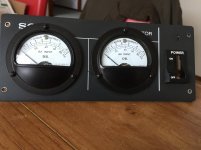Sorry,
I was reading but not comprehending. Previous posters were cautioning against monitoring the output. So that's what I read. Now I'm tracking. Thank you.
I was reading but not comprehending. Previous posters were cautioning against monitoring the output. So that's what I read. Now I'm tracking. Thank you.
Sorry,
I was reading but not comprehending. Previous posters were cautioning against monitoring the output. So that's what I read. Now I'm tracking. Thank you.
No, some of them tried to make clear that class D BTL amplifiers should have no connection between Speaker - and GND. With class D SE amplifiers this is not problem. For some reason many don't grasp that speakers can be connected to 2 points that are both let's say at +30V potential with respect to GND. Between the Speaker + and Speaker - there is then exactly 0 V DC.... Connecting either Speaker + or Speaker - to GND is a full short circuit in such a case. This may happen when connecting a VU/level meter circuit that has a GND connection...to Speaker - ....
When the first bridged car amplifiers came out exactly this error was the most common error made 😉 In such amplifiers both Speaker + and Speaker - were/are at +6.9V DC....
Exactly this:
I guess it is for a SE NC400 but there are apparently Hypex NCore NC400BTL bridged tied load mono blocks out there and the Icepower 50ASXBTL is also in bridged tied load. I’m not saying you can’t hook up a VU meter or an oscilloscope over a BTL but you sure need to know what you are doing and what you are measuring. Short-circuit the two output poles of a BTL is usually not recommended.
For positive inspiration my idea of level meters. Very old airplane meters but new in box...
Attachments
Last edited:
I try to understand why, what’s your rationale? Why measure the speaker output? I find knowing the input level more useful, but that is me...I would prefer to have the VU meters on the output - if I chose to install any 🙂
Dang!! 🙂
An amp is created primarily to drive a speaker, receiving an input is just a necessity...
Now, I don't use meters at all, but if I did, it would be put on the output to monitor the units final result (and not its order/task).
//
An amp is created primarily to drive a speaker, receiving an input is just a necessity...
Now, I don't use meters at all, but if I did, it would be put on the output to monitor the units final result (and not its order/task).
//
😀 But if you know your amplifiers gain then it’s easy to derive the output level from the input (it goes both ways I guess)...Maybe to indicate output level? 😀
The question is if is either measuring or indicating (let alone just visual joy) with output meters but....measuring inputs and deriving output levels truly is indicating no even better it is simply assuming. You will never see a fault at the output like a complete shutdown channel when working like this.
TrueYou will never see a fault at the output like a complete shutdown channel when working like this.
If measuring output level is the main purpose then Rod Elliott got a circuit for that too: P180. I personally like the high/low switch, could be useful to get the "dancing needles" going even on lower levels. The circuit is simple enough to make on a Veroboard and with no need for an additional power feed.Maybe to indicate output level? 😀
Last edited:
- Home
- Amplifiers
- Class D
- VU meter in an NCore400?
